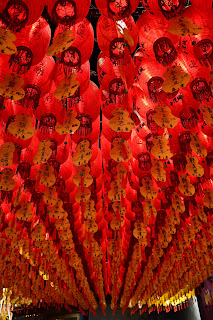Changhua and Lukang
The next
day of our travels, we took the train to Changhua. It is still unbelievable to
me that I can use my public transit card throughout the whole island without
the slightest of difficulties.
The
greatest attraction in Changhua, and the only reason for our visit, is the
Baguashan Buddha, a massive statue erected in the sixties, that overlooks the
city. What surprised me when we got there was that practically all the vendors
were selling meat products, or at the very least fish and dried squid. I do not
remember anything like this happening at the Buddhist attractions of Yunnan –
in fact, many temples had their own vegetarian eateries.
More New Year's lanterns. A taxi driver told me that the festival in Taichung was originally supposed to be held in Changhua but Changhua was too inept and poor to organise anything.
Blooms on the mountain
Statues lining the way to the Baguashan Buddha
A six-armed Buddhist statue
The Changhua Buddha
Phoenix and dragon detail on the roof of one of the temple's buildings
A six-tusked elephant at the entrance of the temple
Dragons at the entrance of the Baguashan Temple
Zach and I
parted ways in Changhua, as he wanted to return to Taipei to audition with a
local choir. In the meantime, I found a taxi and continued westwards to Lukang.
I spent the whole ride in conversation with the taxi driver, who had visited
Prague and Vienna, and was flabbergasted by the European custom of charging for
the use of public toilets. He also reflected on the current epidemic, saying
that it was still nothing in comparison to the SARS epidemic, which had hit
Taiwan much, much worse.
Of the
admittedly few towns and cities I have visited in Taiwan, Lukang struck me as
the most historic and atmospheric. Its name, after all, harkens to the deerskin
trade of the Dutch period – it translates to “Deer Port.” During its heyday
under the rule of the Qing, Lukang was in fact the second largest town in
Taiwan. Nowadays, its main attractions are its numerous temples, as well as its
old street, littered with various shops. Though I could not see the sea, the
abundance of seafood made it clear that the town still takes its position on
the water very seriously.
Getting
back to Taipei was a pain, but fortunately the employees at the Lukang Tourist
Centre were able to direct me to the shuttle to Changhua, which happened to be
readying for the departure as I neared the station. Unsure of where in Changhua
the shuttle headed, and disturbed by its continued veering to the north of town
instead of the centre, I hopped off and took a taxi to the high-speed railway
station. I returned to Taipei by around five o’clock.
Lanterns at the Chenghuang Temple
An idol at the Chenghuang Temple
The entrance to the Tianhou Temple
The inner courtyard at the Tianhou Temple
An intricately carved ceiling at the Tianhou Temple
One of the halls at the Tianhou Temple
A lion railing decoration at the Tianhou Temple
Mazu idol at the Tianhou Temple
Old and weathered painted door at the Tianhou Temple
An idol at the Xinzu Temple
Longshan Temple
The doors of Longshan Temple
Another beautiful wooden ceiling at Longshan Temple
A temple that was not even on my map
More weathered door artwork
A dragon and a phoenix on the roof of Wende Temple
The interior of Wende Temple
A painting at the Wenkai Academy





























Comments
Post a Comment